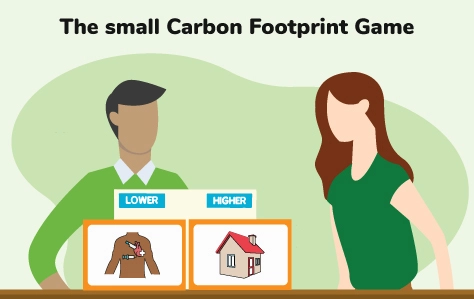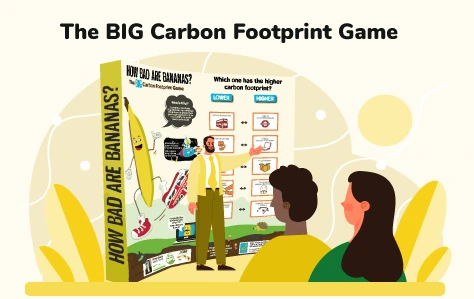An explanation for the confusion
In our quest to educate and inspire people about climate change and carbon footprinting we spend a lot of time talking about and also clarifying with game players what a carbon footprint actually is.
So, we’ve written a blog to explain all the science behind that confusing phrase!
Here is the ‘geek’ definition:
“A carbon footprint is a measure of the total greenhouse gases (GHG) produced by a person, activity, product, service or country. It is usually expressed in equivalent tonnes of carbon dioxide or CO2e”[1].
So from this definition we can see the spotlight isn’t just on carbon dioxide released into the atmosphere… but all the other GHGs too! But what are they? Where do they come from? And what is this CO2e?
The main GHG we all have probably heard of is carbon dioxide. However, carbon dioxide is only one of six main gases or groups of gases that humans emit into the atmosphere and which the International Panel on Climate Change (IPCC) monitor.
Those gases are:
- Carbon Dioxide
- Methane
- Nitrous oxide
- Sulphur Hexafluoride
- Perfluorocarbons
- Hydrofluorocarbons
Are you asleep yet? ;o)
But wait, doesn’t water vapour have a big warming effect too? Yes – you’re correct. Whilst water vapour within the atmosphere has the largest potential to warm the planet, [2] the other gases are more harmful as they have a warming potential that can last into the tens of thousands of years because they don’t break down or they breakdown very, very slowly.
However, just to complicate things more, there’s also the feedback loop of increased water vapour in a warming world, which can make the whole thing hotter still.
But, there’s still five more gases to account for… so where do they come from?
Methane is released from ruminating animals like cows or sheep and even some humans too when we ‘trump’ or even burp! Not everyone emits methane when they trump though – it’s all to do with your gut flora[3]!Methane is also released through rotting rubbish in landfill sights (just another reason to encourage recycling habits)
Anyway… back to GHGs – although this one will definitely have you laughing!
Nitrous oxides, discovered by Joseph Priestly in 1772, were originally used as an anaesthetic. Nowadays, they are mostly released through the breakdown of nitrogen-based fertilisers through agricultural methods. You might recognise the name as its most commonly known as ‘laughing gas’ coined by Sir Humphry Davy in 1800[4] when he observed how it made people giggle!
Sulphur hexafluoride (number 4 on our list above) is a colourless, odourless, non-flammable and extremely potent greenhouse gas[5] but, an excellent electrical insulator used in a number of industrial processes. Unlike laughing gas, it has the opposite effect on the voice if inhaled – making your voice sound deeper more akin to Darth Vadar, David Suchet or Alan Rickman than Mini Mouse!
The last two groups of gases (often known collectively as F-gases or fluorine gases) – perfluorocarbons and hydrofluorocarbons (PFCs and HFCs) were developed to replace CFCs in the 1990s[6] when we discovered that CFCs (chlorofluorocarbons) were depleting the ozone layer. They are mostly used as refrigerants. Unlike methane, which does breakdown relatively quickly in the atmosphere (around a decade) carbon may persist for 200 years and the F-gases for millennia. So, although they are released in much smaller quantities, the overall warming potential of these gases is pretty big over time.
But, if all these other greenhouse gases are included, why do we call it a ‘carbon’ footprint?
Well – to make the maths of GHG accounting just a tiny bit easier, we make all the gases equivalent to carbon when we’re calculating the total carbon footprint of something. Hence we produce a number which is the CO2e or carbon equivalence.
So, what could we do about the misnomer of ‘carbon footprint’?
Probably nothing really. A GHG footprint or ‘Greenhouse Gas Footprint’ (Pheww it just rolls off the tongue doesn’t it?!) is just not as sexy as its carbon shorthand. There’s something so much more tangible about carbon dioxide (or carbon for short), as your average person might conjure up images of smoke rising into the air from the burning of coal, oil or other fossil fuels.
However, as a final thought, does the term ‘carbon footprint’ encourage too much emphasis on burning fossil fuels as the main problem, pushing the less visible but equally important effects of humming fridges, burping bovines and farmers scattering fertilisers onto the side-lines. By using the word ‘carbon’ are we fuelling a one sided image of the effects of climate change all in the attempt to name it as one thing when the reality is we need to focus on all the greenhouse gases if we really want to how much are planet is warming.
[1] See this article by Mike Berners-Lee for his definition of a carbon footprint https://www.nationalgeographic.co.uk/environment-and-conservation/2022/06/what-is-a-carbon-footprint-and-how-to-measure-yours
[2] https://www.nasa.gov/topics/earth/features/vapor_warming.html
[3] https://en.wikipedia.org/wiki/Flatulence
[4] www.bbc.co.uk/history/historic_figures/davy_humphrey.shtml
[5] www.sciencedaily.com/terms/sulfur_hexafluoride.htm
[6] https://climate.ec.europa.eu/eu-action/fluorinated-greenhouse-gases_en








